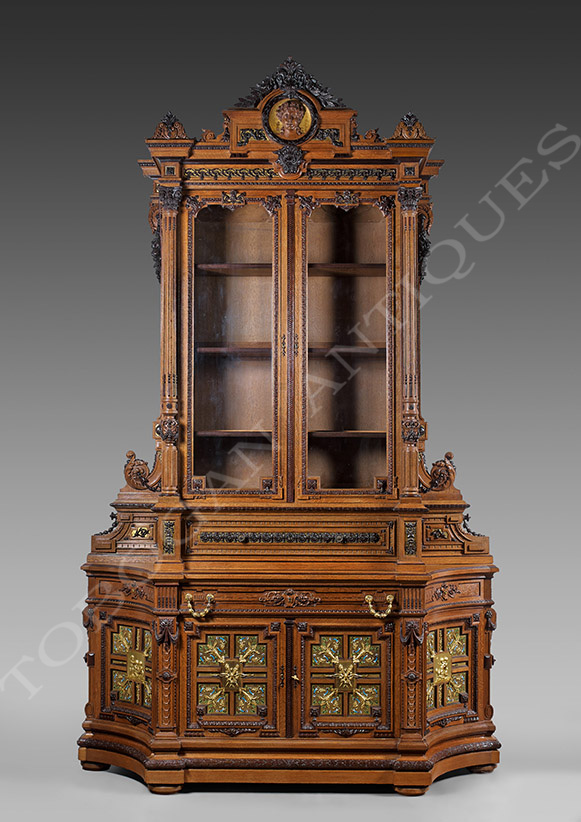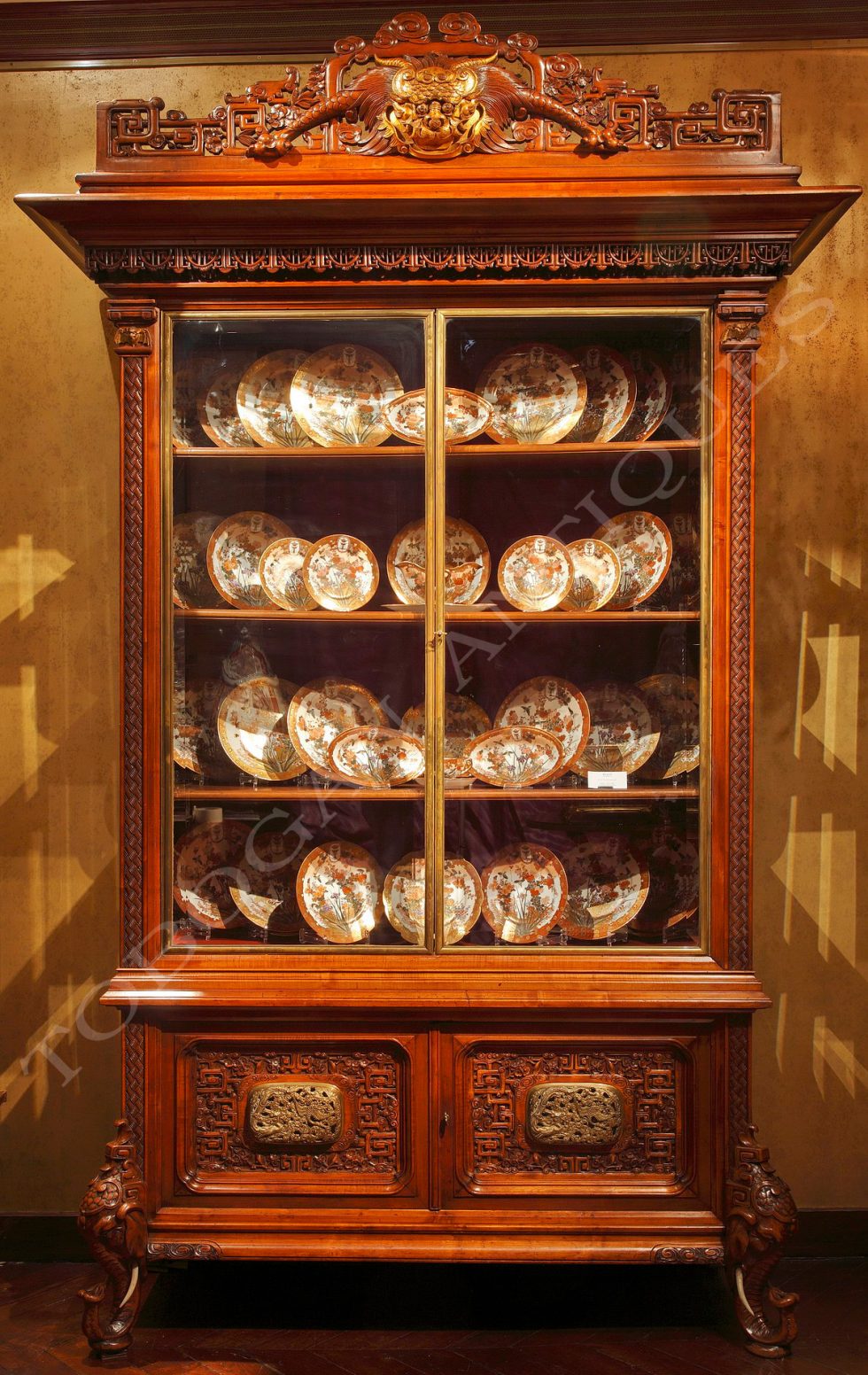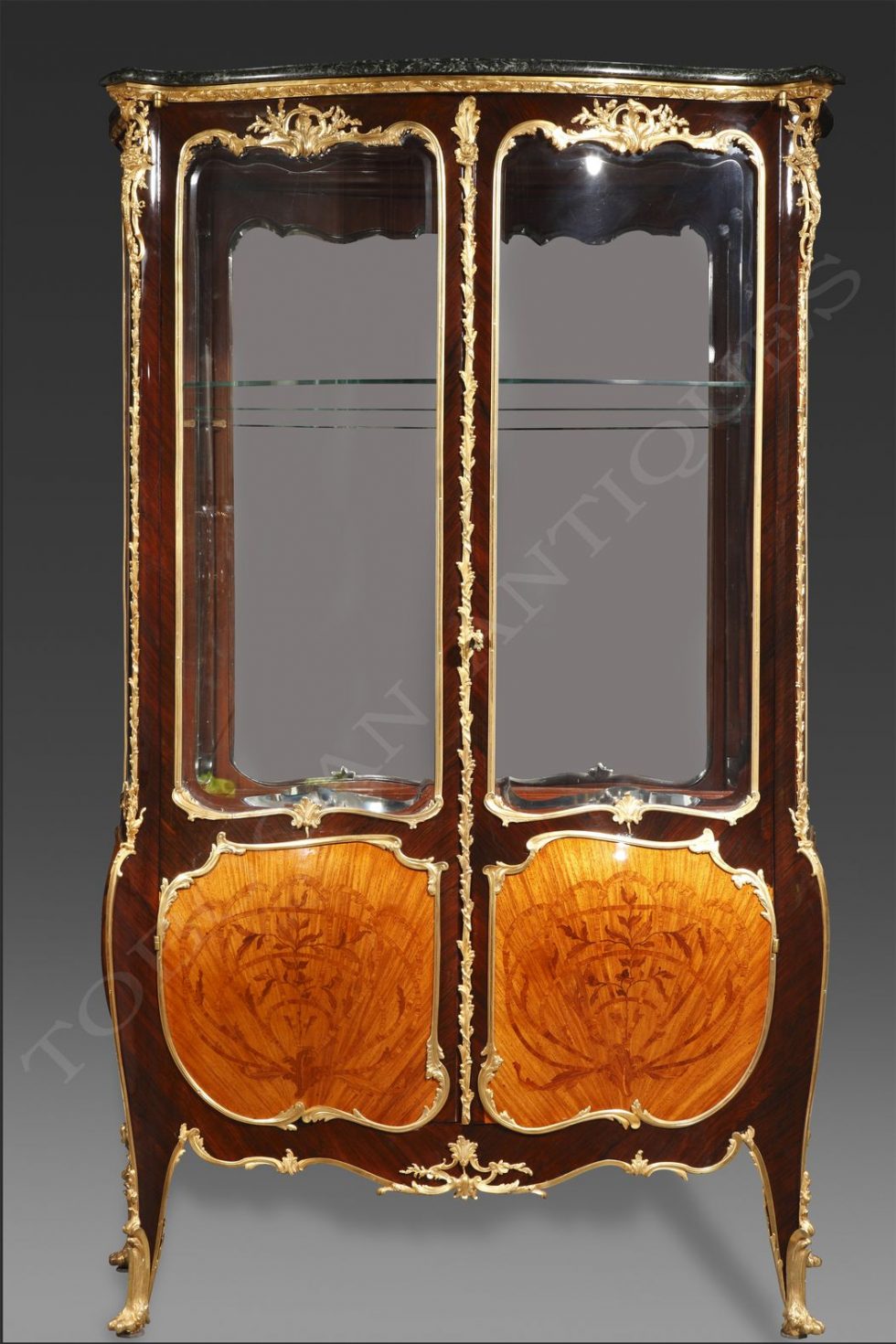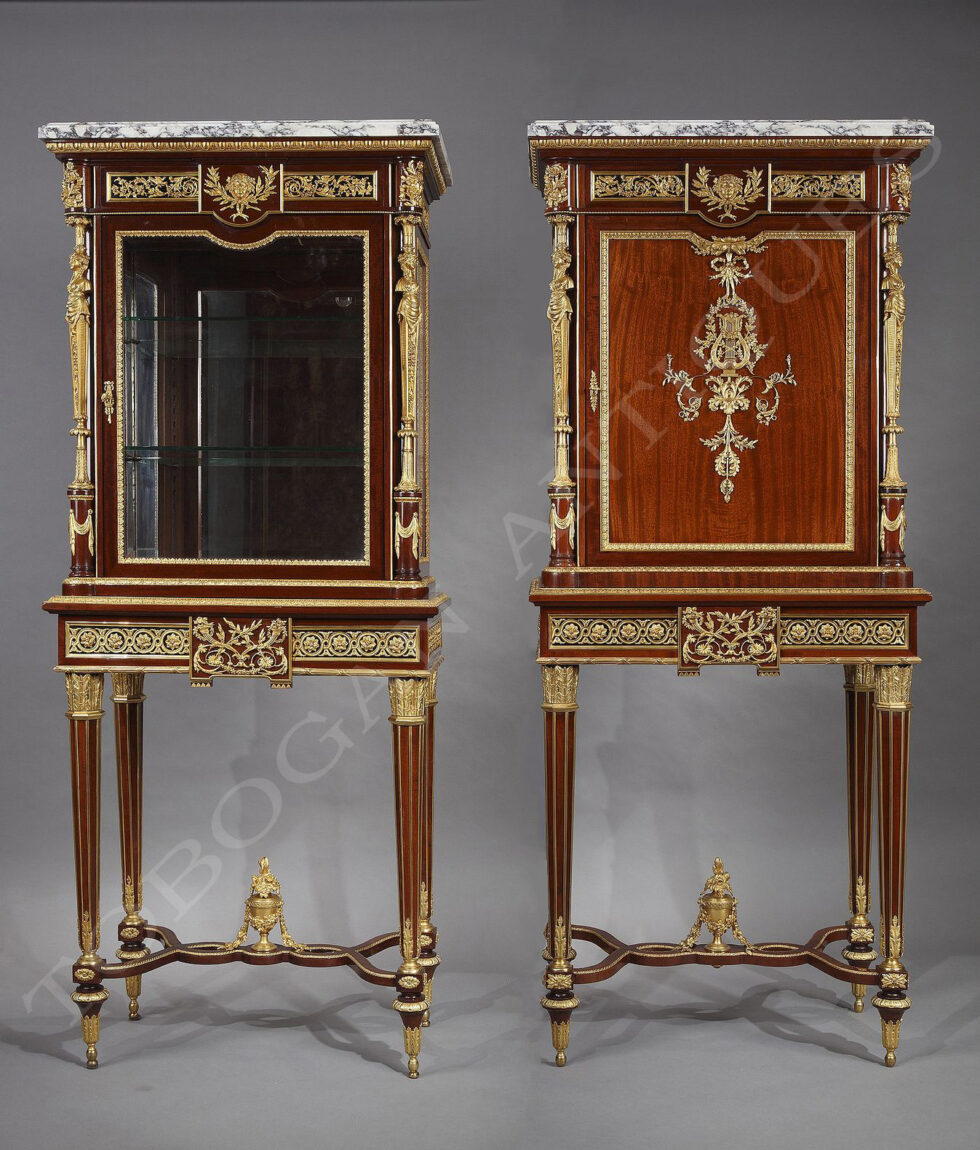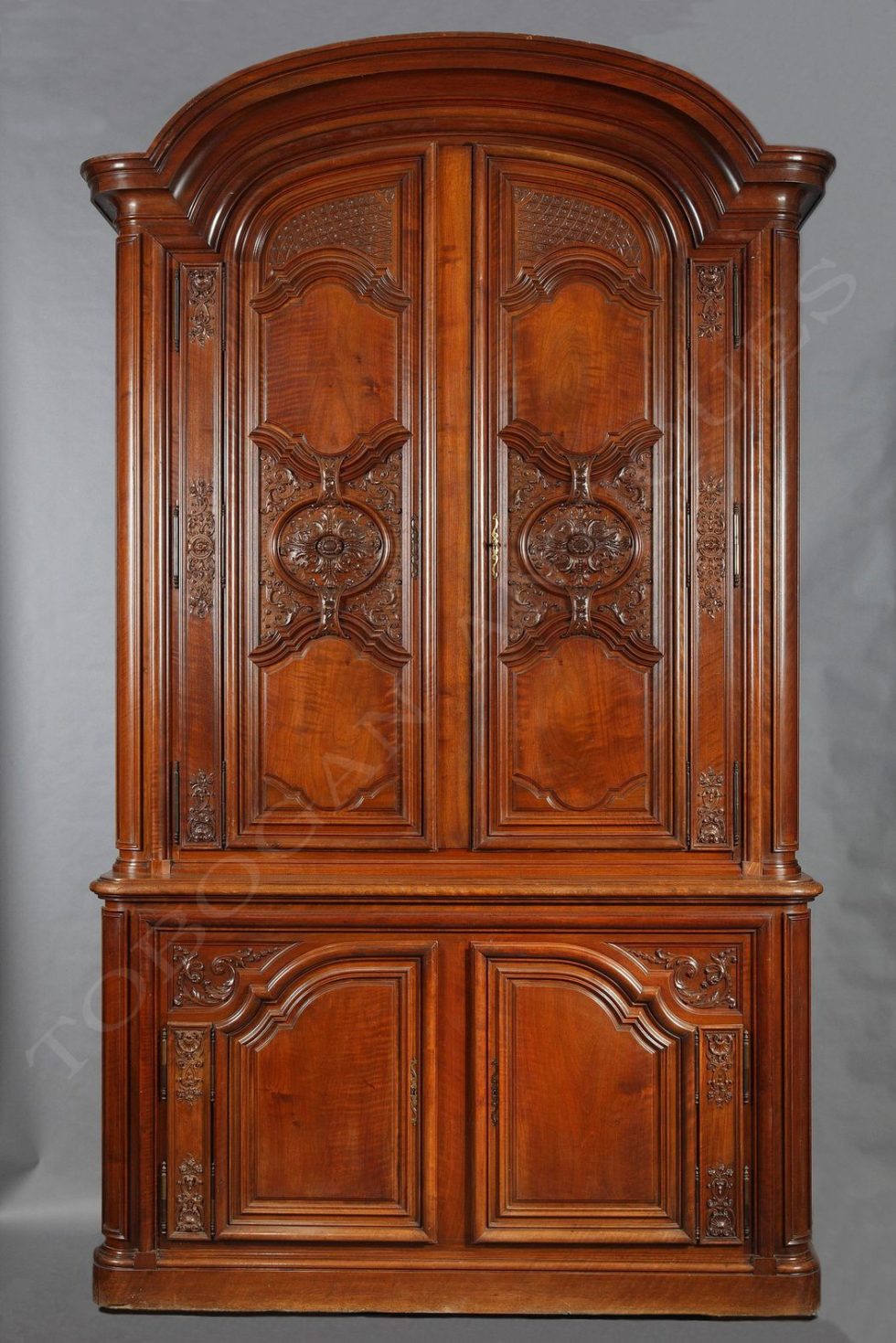Ref. 228
H.-A. Fourdinois
Cabinet-maker
(1830-1907)
(attributed to)
Rare display sideboard
France
Circa 1867
Natural oak, Amaranth, Enamel, Gilt bronze
Height : 332 cm (130,7 in.) ; Width : 200 cm (78,7 in.) ; Depth : 54 cm (21,2 in.)
Important two-tiered sideboard made in natural oak and carved amaranth wood: the lower part made up of four panels, two concave ones and two doors, richly ornated with a polychrome enameled floral decoration and gilt bronze plaques.
A large dual drawer is surmounted by the upper part of the sideboard, opening with two glazed doors, framed by detached columns. The entire unit is topped with a pediment onto which a female bust is carved in relief within a medallion on a gilt background.

The Forney library in Paris preserves order registers of the Fourdinois as well as sketches books and pictures representing pieces of furniture made by the Fourdinois workshops. In this documentation, some elements enable us to link this sideboard with Henri-Auguste Fourdinois’ productions, such as the large scrolls linking the upper part to the lower part of the sideboard, as well as the detached columns carved at their lower third.

Notebook containing ink-sketches coming from the Fourdinois workshop shows a project for a pelmet, beautified with a centering trophy composed of a torch and a quiver within in a foliage wreath, this motif obviously reused by the Fourdinois on the central decoration of the panels of our sideboard.
Biography
The firm of Fourdinois, considered during the Second Empire as the greatest furniture manufacturer in Paris, was founded in 1835 by Alexandre-Georges Fourdinois (1799-1871). It was developped in the context of the Expositions Universelles. At the time, the firm already produces furniture of the Neo-Renaissance style, such as a dresser that won the Great Medal at the London Universal Exhibition of 1851. The son, Henri-Auguste Fourdinois (1830-1907), joined the firm in 1860 and will become head of the firm in 1867. The high quality of his designs was remarked at the Universal Exhibition in 1862, when the jury awarded him two medals « for Excellence of Composition and Execution ». Henri-Auguste, now sole in charge, brought the firm to the summit of its achievements at the 1867 Universal Exhibition in Paris by winning the Grand Prize for his stand. Apart from the commissions he executed for the « Mobilier de la Couronne », he also produced high quality furniture for the Parisian bourgeoisie. The firm is at its zenith during the years 1862-1880. At this time, it is considered as an example to follow for other cabinet-makers, whether they are French, British or American.
Through the quality of execution and the extreme care taken in the decoration of furniture, H.-A. Fourdinois was particularly appreciated by Napoleon III and Eugenie, who ordered him to furnish several imperial residences, such with the bedroom of the apartment of the Pope at Fontainebleau Palace. Among his talents, Fourdinois knew how to match furniture with elaborate and luxurious sets, thus causing him to become one of the preferred suppliers of the Empress Eugenie. His meticulous work was in particular made thanks to the new technique of “en plein” marquetry, a decorative technique invented by H.-A. Fourdinois himself, for which he registered a patent allowing him to have the monopoly to use this technique. This new technique is quite different from the traditional marquetry which put together wood sheets veneered on a furniture piece. In Fourdinois’ “en plein” marquetry, the inlaid wood is joined together with the wooden structure of the furniture piece, allowing the cabinet-maker to carve directly the inlaid wood. Such a technique enabled to inlay different types of wood inside the structure as well as precious stones, ivory, slate, etc.
Museology
– Monumental inlaid door, with enameled decoration, shown at the Universal Exhibition of 1878, preserved at the Orsay Museum, Paris (Inv. DO 1980 1).
– A walnut two-tiered cabinet inlaid with bloodstone, lapis-lazuli, ivory and silver, preserved at the Decorative Arts Museum, Paris (Inv. 29921).
– The bedroom set of the apartment of the Pope at Fontainebleau Palace, preserved in situ.
– Psyche of Empress Eugenie’s toilet cabinet at Saint-Cloud Palace, preserved at Compiègne Castle.
Bibliography:
– Sources et modèles d’un ébéniste au XIXe siècle: l’exemple d’Henri Fourdinois (1830-1907), Olivier Gabet, in Bulletin de la Société de l’Histoire de l’Art Français, Paris, 2003, p. 261-278.
– Marqueteries virtuoses au XIXe siècle, brevets d’invention, Marc Maison et Emmanuelle Arnould, Paris, 2012, p. 12-14 et 48-59.
– Croquis et commandes, Henri-Auguste Fourdinois, Fourdinois Rue Amelot Paris, 1855-1865.
– Nouveau recueil d’ameublement: meubles, sièges, lits, tentures, tapisseries, etc., Henri-Auguste Fourdinois, Librairies Imprimeries Réunies, 1890, Vol. I.
Contact us
Tobogan Newsletter
If you want to be up-to-date with our new acquirings you can sign up to our newsletter.

